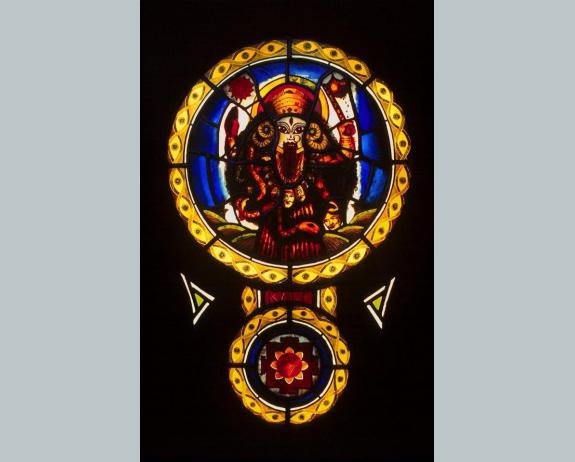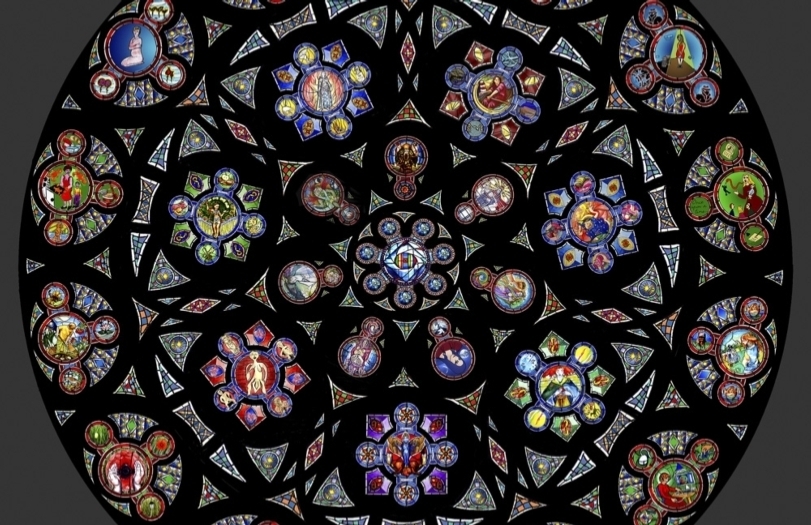Stained glass exhibition to light up a Bristol crypt
Artist Delia Whitbread opens an exhibition of stained glass in the crypt of St John on the Wall in Bristol to celebrate International Women’s Day.
‘Kali in the Crypt’ includes medieval and Victorian stained glass from our collection and marks the launch of the Bristol Rose Project, developed by and for the women of Bristol. Stories of women’s experiences will be gathered over the course of the year and woven into a design for a new stained glass rose window.
We recently had the opportunity to speak with Delia about her inspirations, her own art, and her volunteering work at St John on the Wall.
Which artworks most inspired you as you were growing up?
I grew up in Birmingham, which hosts the UK's largest collection of Pre-Raphaelites work. Like a lot of young people, I loved the romanticism of the Pre-Raphaelites and their use of bright colour and detail. Birmingham Art Gallery has a room dedicated to [British artist and designer] Edward Burne-Jones, who lived in the city. I was particularly inspired by his Holy Grail tapestries because I loved the Arthurian legends. At that time the tapestries weren't valued and were left hanging in the big Lecture Hall; if the museum wardens were in a good mood they would let you in to look for as long as you liked. These days, the tapestries are stored away from daylight and you can only see them at special exhibitions. I loved stories and at that time wanted to be a book illustrator - it was with that ambition that I went to art college in 1968.
How would you describe your work?
I focused on oil painting and etching before I turned to stained glass. My favourite glass is still that of the early Middle Ages where strong colour, vivid storytelling and humorous details make up even the most sacred stories. In my figurative work I like to create a strong narrative so the viewer knows they are looking at a moment in time in a broader story – such as in my commission for St John Vianney Church in Bexleyheath, The Holy Family Leaving Egypt. Here, the backdrop of date palms, camels and pyramids frames a simple family departure where an apprehensive Jesus, carried by his father Joseph, takes the flowers his mother has picked for him as a distraction before they embark on the long journey home to Palestine – a place he does not know and in which he has never lived. I also have a great love of geometry which I use to underpin both my narrative and abstract work.
Why did you choose the crypt at St John on the Wall to display your stained glass? How will you choose which pieces to display?
In 2015, there was an exhibition of stained glass in light-boxes down in the crypt. I realised what a great space it is for backlit exhibitions as it is dark enough for the glass to glow in all its glory. In the upper church there is too much ambient light for such a dramatic effect. As my stained glass is largely inspired by 13th-century glass that was being made all over Europe at the same time that St John's was built, it seemed the ideal place to display my work. Choosing the glass was easy as my glass goddesses have never been displayed collectively in an exhibition before. I liked the idea of juxtaposing Hindu images like Kali, whose shrines in Indian temples are always dark like caves, with the Christian space above.
What has been your involvement at The Churches Conservation Trust to date?
I have worked as a volunteer for St John on the Wall on and off for the last five years. At first, I just used to love coming and sitting in the upper church early in the day, even when there were hardly any visitors. I enjoyed telling visitors about the medieval glass that is preserved in the upper clerestory windows. I can talk for hours about the designing and making of stained glass and I am happy to share that. St John's is such an inspiring place: large enough to impress, but small enough to feel intimate. The crypt is particularly redolent of the mystery of 1,000 years of history. I am really pleased to have found a way of displaying my work in this wonderful space.

More about the artist:
Delia is the artist behind ‘In the Womb of the Rose’, a digital montage of illustrations of iconic female figures created by 17 women artists from across the world. The project began in 1988, when she researched the history of gender and iconography as a student at the Royal College of Art and created a prizewinning design for a rose window celebrating the feminine. Since then, Delia has expanded the project in a labour of love lasting 30 years. It formed the focus of her PhD project at Sunderland’s National Glass Centre, and inspired a collaborative project called ‘Reconfiguring the Rose’ that also celebrates women.
Delia moved to Bristol in 2011 and has a studio in Stokes Croft. She read English and Sociology at the University of York and taught in Indonesia, where she developed her love of Eastern art. After several years teaching in London’s secondary schools, Delia retrained in mural design at Chelsea School of Art in 1986 and went on to study Visual Islamic and Traditional Arts at the Royal College of Art, where she earned an MA. She has been working as an architectural glass artist for 25 years and has also lectured on Architectural Glass and the History of Art on the Art for the Community and Women’s Studies courses at Roehampton University, Surrey.
'Kali in the Crypt' exhibition and series of accompanying talks runs at St John on the Wall, Bristol, from 9–28 March. Find out more here.

